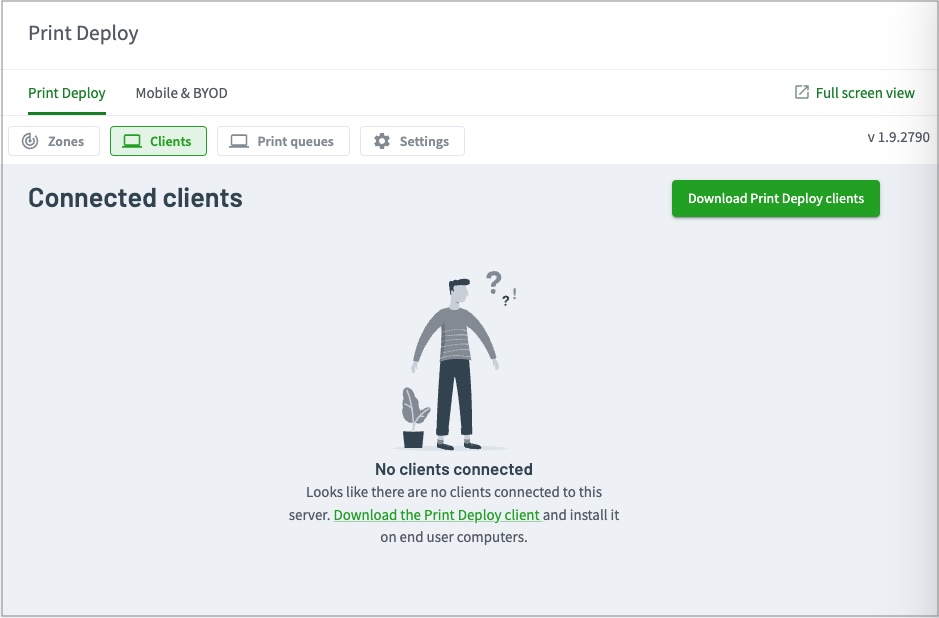This page describes how to install the Print Deploy VDI client in your Microsoft Remote Desktop Services (RDS) environment.
Before you start, you might want to look at:
- the description of the Print Deploy VDI Client
- information about the different deployment options for RDS .
The Print Deploy VDI Client comprises 2 components:
- System Context Service (SCS) - The main component of the Print Deploy VDI Client. It runs in the background in the provisioning servers. The SCS does most of the work, including session monitoring, communicating with the Print Deploy Server, and print queue management.
- User Context Tool (UCT) - The user-facing frontend of the Print Deploy VDI Client. It gets deployed as Mainly used to manage optional printers and user authentication. It communicates with the Print Deploy Server via the SCS.
RDS Session Hosts or Azure Virtual Hosts will have Print Deploy VDI Client installed. Session Host Server(s) serve up unique Sessions to End User Terminals via Remote Desktop Protocol (RDP) Clients.
This procedure covers installing both components.
Procedure
- On the PaperCut MF admin interface, click Enable Printing. The Print Deploy page is displayed.
- Click the Clients button.

- Click Download Print Deploy clients. The Download Print Deploy clients page is displayed.
- Click theVDI tile and download the VDI client. The download file is named something like pc-print-deploy-client-vdi[10.50.60.2].zip, where the PaperCut MF app server IP address is included in the zip file name. [10.50.60.2] is just an example.
- Rename the 2 installers within the .zip file to include the same IP address, for example:
pc-print-deploy-client-uct-installer[10.50.60.2].msipc-print-deploy-client-vdi-installer[10.50.60.2].msi - Install both
.msifiles on the same provisioning server. - In the Windows Services Management Console, confirm that these two related Windows services are up and running.
- PaperCut Direct Print Monitor
- PaperCut Print Deploy Client for VDI

- In the Install directory, open the config file and check the Print Deploy VDI Client is pointing to the PaperCut MF Application Server.

- Go to C:\Program Files\PaperCut Print Deploy Client VDI\direct-print-monitor\providers\print\win and check the Direct Print Monitor configuration is pointing to the same PaperCut MF Application Server as the VDI Client.

Different deployment options for Microsoft RDS
Microsoft RDS is a great turnkey for virtual Desktop and Application Delivery. Similar to other VDI solutions such as Citrix and VMWare Horizons, Microsoft RDS can be a good option for businesses that are familiar with the now deprecated Terminal Services but need flexibility and function similar to other popular VDI solutions.
Microsoft RDS can be delivered via On-Prem RDS Servers (Farms) or via Azure’s RDS Services. In both instances, you need to understand whether desktops are being served via a Hyper-V Image or via a “Session”, hence where the Print Deploy VDI Client is actually installed.
Hyper-V image desktops
The session can be persistent or non-persistent, but in either case, the Print Deploy VDI Client will be installed on the “Master” VM Image(s).
The User and Desktop are essentially a “One to One” (one user accesses one desktop session) in this deployment method. The Print Deploy VDI Client uses the hostname attribute (against the zone) to identify the actual host terminal to deploy printers to.
Session-based desktops
A session-based RDS session is basically sharing the Desktop from a Remote Desktop Services Host (RDSH) via Remote Desktop Protocol (RDP).
- The Print Client for VDI is installed on the RSDH Server(s) and each session has a unique “Session ID” recognized by the Print Deploy VDI Client.
- Each user who is logged in to RDS has a unique session and therefore attributes such a Groups for defining Zones is recognized and applied to the session.
- Clientname is also recognized in RDSH Sessions as the identifier for the Client Terminal, regardless of O/S type. Print Deploy captures and translates this “Clientname” as the “Hostname”, so it can also support the “Hostname” parameter in Zones for a more narrow type of Zone configuration.






Comments